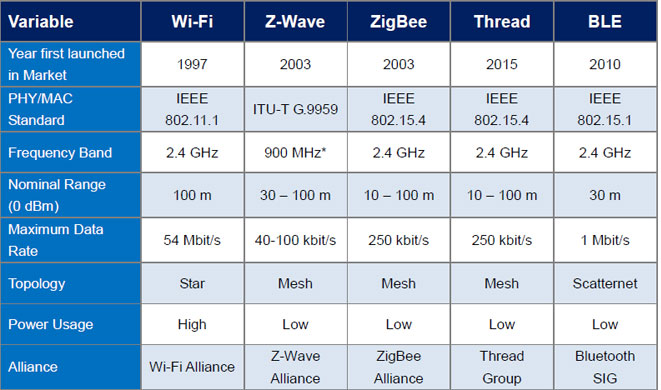You’ve listed several different wireless communication technologies. Each of these technologies serves different purposes and has its own advantages and disadvantages. Let me provide you with a brief overview of each one:
- Wi-Fi (Wireless Fidelity): This widely used wireless networking technology enables devices to connect to the internet and communicate with each other over short to medium distances. It operates in the 2.4 GHz and 5 GHz frequency bands, known for their high data rates and relatively long range compared to some other wireless technologies.
- Zigbee: Zigbee, a low-power, low-data-rate wireless communication technology, finds applications in home automation and IoT (Internet of Things). It operates in the 2.4 GHz frequency band and is designed for low-power consumption and mesh networking, allowing devices to relay messages through one another.
- Z-Wave: Similar to Zigbee, Z-Wave is another wireless technology primarily used for home automation and smart devices. Operating in the sub-1 GHz frequency range, it offers good range and reliability for smart home applications.
- Matter (formerly Project CHIP – Connected Home over IP): Matter serves as an open-source connectivity standard aiming to unify smart home devices, ensuring interoperability across various ecosystems. Its objective is to establish a common framework for devices to communicate irrespective of the wireless technology used.
- Radiofrequency 433 MHz: This frequency is commonly used for simple wireless communication, such as remote controls, weather sensors, and certain home automation devices. Its use is prevalent in short-range applications due to its lower data rates.
- Infrared (IR): Infrared communication utilizes light in the infrared spectrum to transmit data. Commonly applied in remote controls, it necessitates line-of-sight communication and is effective over short distances.
- BLE (Bluetooth Low Energy): BLE, designed for short-range communication with low power consumption, is prevalent in applications like fitness trackers, smartwatches, and devices requiring periodic data exchange.

Choosing the appropriate technology depends on your specific application requirements:
- Range: Wi-Fi, Zigbee, or Z-Wave are suitable for longer range needs.
- Power Consumption: Zigbee, Z-Wave, or BLE are optimal for low-power devices.
- Interoperability: Matter enhances interoperability among diverse devices.
- Data Rate: Wi-Fi is a viable choice for high data rates.
- Line-of-Sight: IR is beneficial for direct line-of-sight communication.
- Application: Your devices’ specific use case will dictate the most fitting technology.
Keep in mind that technology landscapes evolve, so it’s wise to stay updated on the latest developments and standards before making a decision.
#SmartHome #ConnectivityProtocols #WiFi #Zigbee #ZWave #Matter #RF433 #Infrared #BLE #HomeAutomation #IoT #WirelessCommunication #Interoperability #SmartDevices

